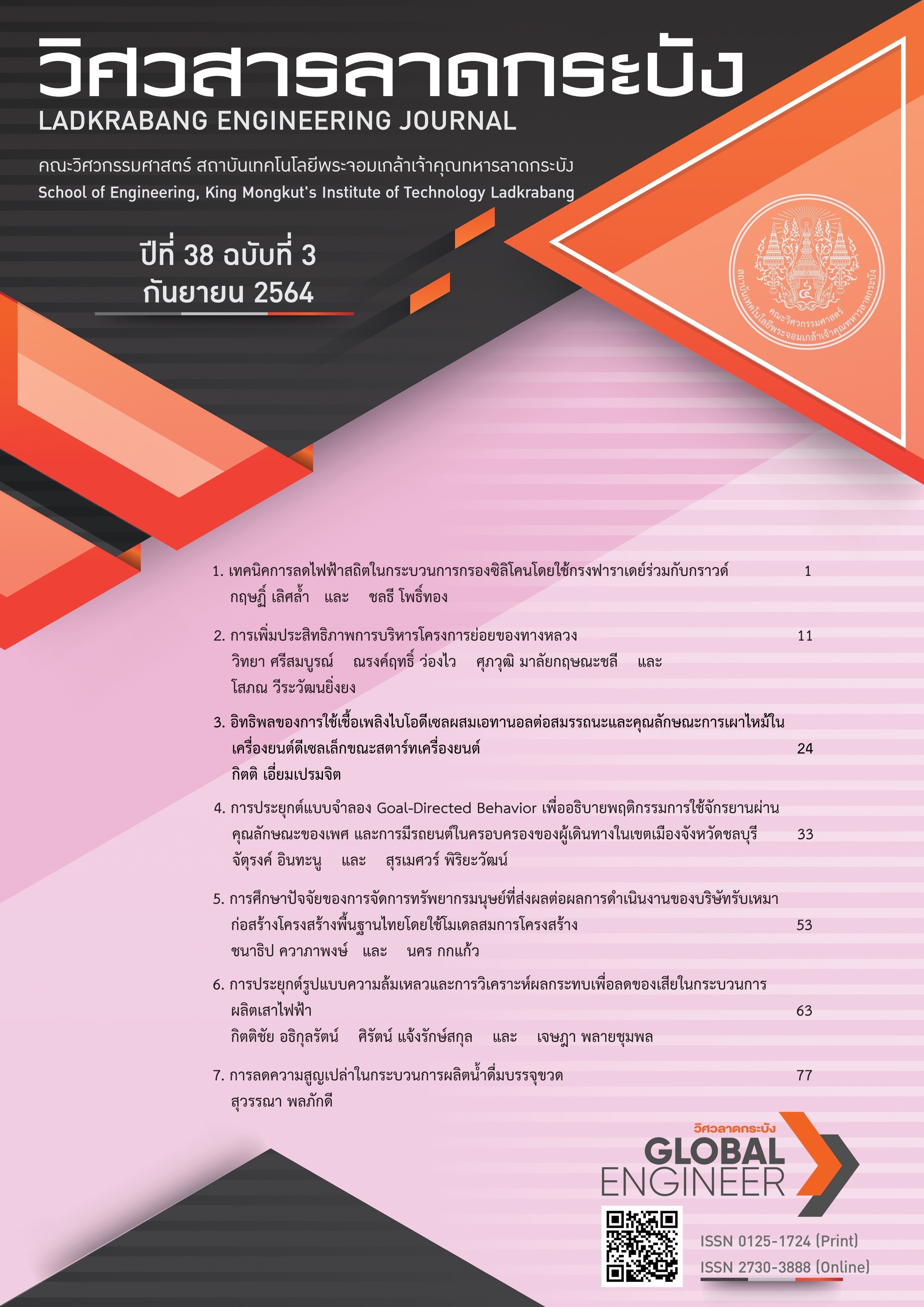A Study of Factors of Human Resource Management Influencing the Performance of Thai Infrastructure Contractors Using Structural Equation Modeling
Keywords:
Human resource management, Performance of Thai Infrastructure Contractors, Structural Equation Model, Confirmatory Factor AnalysisAbstract
Thailand has invested in many key infrastructure projects, which attract not only large Thai construction firms but also international ones, especially those from China. One of the things that Thai infrastructure construction firms can do is to strategically employ human resource management (HRM) practices so as they may remain competitive. Despite having several studies about the use of HRM for increasing firms’ performance and competitiveness, there are limited studies of HRM and firm performance in the construction industry, in particular the Thai infrastructure construction sector. Therefore, this study is to investigate into which of the HR practices could lead to the increase in firms’ performance measured using Balanced Scorecard (BSC). The study uses structural equation modeling (SEM) to analyze the data set collected from 203 engineers of 67 firms. The results found that HR practices indeed had a high influence on firms’ performance, with the correlation coefficient of 0.88. In addition, based on confirmatory factor analysis (CFA), the HR practice that has the highest regression weight (i.e., 28.33%) is “recruitment and selection.” To our surprise, aggregated financial indicator was found to have a loading factor of 0.08, which indicated that there is no relation between the financial indicator and the rest of performance indicators. Finally, the results of this study may be used by Thai infrastructure construction firms for operational and performance improvement through HRM.
References
V. Jiradumgeng, “Construction project,” in Construction Management, Pathumthani, Thailand: Rangsit University Printing House, 2000, pp. 2–8.
K. Wangniwetkul, “Introduction,” in Management in Construction Engineering, Bangkok, Thailand: S. Asia press, 2004, pp. 11–12.
Krungsri Research, “Industry Outlook 2019-2021: Construction Contractor,” Bank of Ayudhya Public Company Limited., Bangkok, Thailand, Aug. 10, 2019. [Online]. Available : https://www.krungsri.com/bank
/getmedia/7fe1e975-13f4-4040-a276-0d40841e504b
/IO_Construction_Contractor_190606_TH_EX.aspx.
D. Harvey and R. B. Bowin, “The Success System: Anticipating Success” in Human Resource Management: An Experiential Approach, 1st ed. New Jersey, United States: Prentice Hall, 1996, pp. 6.
G. Dessler, “The Strategic Role of Human Resource Management” in Human Resource Management, 9th ed. New Jersey, United States: Prentice Hall, 2003, pp. 4–5.
S. Juito, “Strategic Human Resource Management” in The new dimension of human capital management. Nonthaburi, Thailand: Sukhothai Thammathirat Open Universiry, 2011, pp. 12–18.
T. Wattanasupachoke, “Strategic human resource management and organizational performance: A study of Thai enterprises,” Journal of Global Business Issues, vol.3 , no. 2, pp. 139–148, 2009.
M. A. Huselid, “The impact of human resource management practices on turnover, productivity and corporate financial performance,” Academy of Management Journal, vol.38, no.3, pp. 635–872, 1995.
S. Akhtar, D. Z. Ding and G. L. Ge, “Strategic HRM practices and their impact on company performance in Chinese enterprises,” Human Resource Management Journal, vol. 47, no. 1, pp. 15–32, 2008 doi: 10.1002/hrm.20195.
Y. Abdallat, T. Suifan, K. Oklah, G. J. Sweis and R. J. Sweis, “The impact of human resource management practices on organizational performance in construction companies in Jordan,” International Journal of Business Innovation and Research, vol. 23, no. 4, pp. 515–539, 2020, doi: 10.1504/IJBIR.2020.10025591.
R. Kaplan and D. P. Norton, “Strategic Learning & The Balanced Scorecard,” Strategy & Leadership, Vol. 24 No. 5, pp. 18–24, 1996, doi: 10.1108/
eb054566.
S. Gurbuz and I. S. Mert, “Impact of the strategic human resource management on organizational performance: Evidence from Turkey,” The International Journal of Human Resource Management, vol. 22, no. 8, pp. 1803–1822, 2011, doi: 10.1080/09585192.2011.565669.
J. E. Delery and D. H. Doty, “Modes of theorizing in strategic human resource management: Tests of universalistic, contingency, and configurational performance predictions,” Academy of Management Journal, vol. 39, no. 4, pp. 802–835, 1996, doi: 10.2307/256713.
P. M. Wright, T. M. Gardner and L. M. Moynihan, “The impact of HR practices on the performance of business,” Human Resource Management Journal, vol. 13, no. 3, pp. 21-36, 2003, doi: 10.1111/j.1748-8583.2003.tb00096.x.
B. A. O. Dimba, “Strategic human resource management practices: effect on performance,” African Journal of Economic and Management Studies, vol. 1, no. 2, pp. 128–137, 2010, doi: 10.1108/20400701011073455.
X. Zhai, A. M. Liu and R. Fellows, “Role of Human Resource Practices in Enhancing Organizational Learning in Chinese Construction Organizations,” Journal of Management in Engineering, vol. 30, no. 2, pp. 194-204, 2014, doi: 10.1061/(ASCE)ME.1943-5479.0000207.
N. Wiratchai, “Research Model and LISREL,” in LISREL Model: Statistical Analysis for Research, 3rd ed. Bangkok, Thailand: Chulalongkorn University Printing House, 1999, pp. 2–5.
R. E. Schumacker and R. G. Lomax, “Data Entry and Edit Issues,” in A Beginner’s Guide to Structural Equation Modeling, 1st ed. Mahwah , NJ, USA: Lawrence Erlbaum Associates, 1996, pp. 12–16.
J. F. Hair, R. E. Anderson, R. L. Tatham and W. C. Black, “Analysis Using Dependence Techniques,” in Multivariate Data Analysis, 7th ed. hoboken , NJ, USA: Prentice Hall, 2010, pp. 154–176.
R. J. Rovinelli and R. K. Hambleton, “On the use of content specialists in the assessment of criterion-referenced test item validity,” Paper presented at the annual meeting of the American Educational Research Association : California. April 19–23, 1976 [Online] Available : https://files.eric.ed.gov/
fultlext/ED121845.pdf.
P. Panayides, “Coefficient Alpha: Interpret With Caution,” Europe’s Journal of Psychology, vol. 9, no. 4, pp. 687–696, 2013, doi: 10.5964/ejop.v9i4.653.
K. A. Bollen, “Confirmatory Factor Analysis” in Structural Equations with Latent Variables. 1st ed. New York, NY, USA: John Wiley and Sons Inc, 1989, pp. 250–278.
Downloads
Published
How to Cite
Issue
Section
License
Copyright (c) 2021 Faculty of Engineering, King Mongkut’s Institute of Technology Ladkrabang

This work is licensed under a Creative Commons Attribution-NonCommercial-NoDerivatives 4.0 International License.
The published articles are copyrighted by the School of Engineering, King Mongkut's Institute of Technology Ladkrabang.
The statements contained in each article in this academic journal are the personal opinions of each author and are not related to King Mongkut's Institute of Technology Ladkrabang and other faculty members in the institute.
Responsibility for all elements of each article belongs to each author; If there are any mistakes, each author is solely responsible for his own articles.






